Zermatt is all about snow sports and can be done 365 days a year. As of the autumn and throughout the winter, up to three quarters of the ski runs and pistes can be provided with snow or lie ahead of glacier’s ground. It is a field which Zermatt has established a pioneering body of knowledge. Zermatt’s skiing area expands during autumn and shrinks in late spring. The state of play in early October every year, the skiing are on the Theodul Glacier and around the Matterhorn glacier paradise covers more than 21 kilometers. More and more kilometers are to be added through to mid-December until a total of 360 kilometers of ski runs are available.
In early October the teams of snowmakers get to work on the southern and northern areas. They fetch the 900 snow laces and low-pressure machines from the depots and posts them throughout the Zermatt skiing region. A key partner at this stage is Air Zermatt and its helicopters. Once all the snow making equipment is ready, the water begins to flow through the pipes and hoses. The wet bulb temperature, which consists of the air humidity and the air temperature is used to calculate the right time for starting up the snow guns. Once the wet bulb temperature readings are right, the workers work 24 hour shifts to create snow.
For creating a good piste, the condition and the foundation is important. The workers use the snow making facilities down the sides of the slopes to a good foundation making a properly prepared foundation layer of snow which helps protect the ground and bears up to the pressure loading of thousands of snow sports enthusiasts. Zermatt is situated in an area with low precipitation, so it is important to ensure that the ground layer of snow is sturdy and long lasting. As soon as nature decides it’s time to start snowing, the snowcats are deployed to level off the new snow that has fallen on the pistes preparing for the artificial snow.
Artificial or man-made snow consists of the finest water droplets. They are sprayed into the air using snowmaking lances and snow guns. As they are falling to the ground in approximately 10 seconds, they freeze. As man-made snow freezes from the outside in, the grains are round and only 0.1 to 0.8 mm in size compared to snowflakes, which fall from the sky out of the cloud. Snowflakes grow from the inside out and have a ramified, crystal like structure. They are much larger than the grains of artificial snow.
With its proven expertise in the field, Zermatt is regularly contacted by manufacturers of snow making equipment. They set up their prototypes across their region, test them, then draw reports that provide detailed information on the pros and cons of each piece of equipments. Also the featuring of the new products gains the backdrop of the Matterhorn looks stunning in the advertising brochures. The machine isn’t a perfect snow making machine, but it does create a wonderful snow allowing all the visitors to enjoy the pistes.



